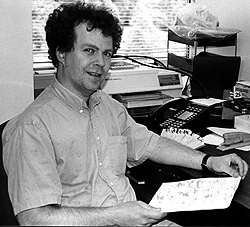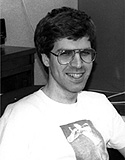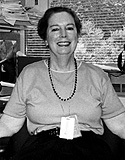
| T H E N I H C A T A L Y S T | J U L Y – A U G U S T 1997 |
|
|
|
NIHERS PLAY MULTIPLE ROLES IN BRCA STUDY |
by David Ehrenstein |
 |
|
Sholom
Wacholder
|
On May 14, intramural researchers from NCI and NHGRI held a joint press conference here to announce the findings of their highly publicized study to determine cancer risk associated with BRCA1 and BRCA2 gene mutations in a general population of Ashkenazi Jews. That "general" population may have included a fair share of Ashkenazi Jews from NIH itself; it almost included two of the study’s very own researchers.
First the findings: Among their study sample of of 5,318 Ashkenazi Jewish volunteers living in the Washington metropolitan area, NCI-NHGRI scientists Jeffery Struewing, Patricia Hartge, Sholom Wacholder, and their NIH and industry colleagues found a 56 percent risk of breast cancer by age 70 associated with any one of three specific genetic mutations—higher than the risk without such mutations but lower than previous estimates of 76 to 87 percent, based only on findings from families with high cancer rates. Similarly, the 16 percent elevated risk of ovarian and prostate cancer was lower than that observed in high-incidence families. The relatively high rate of these mutations among Ashkenazi Jews (2.3 percent of the 5,318 volunteers) allowed the researchers for the first time to study the mutation-associated cancer risk in the general population.
Agreeing to be tested for mutations that confer cancer risk is no small matter, and since the advent of the ability to identify BRCA mutations, many people, especially women, have expressed great reluctance to submit to a test whose results might generate little more than health insurance discrimination and fear. Study designers avoided these issues by testing the subjects anonymously, not returning results to individuals, and destroying all information connecting identities with genetic data.
 |
|
David
Ehrenstein
|
Although the study participants were anonymous, the investigators had put up notices on the NIH campus and at likely spots near campus asking for volunteers—and 58 percent of the participants turned out to have graduate degrees (in fact, the author of this article was one of them)—so we at The Catalyst wondered whether lots of NIH denizens had volunteered themselves for this study. Access to the study for NIHers was easy because the Clinical Center was one of the major blood-collection sites. After the findings were released at the press conference, The Catalyst put out a call over the NIH fellows e-mail list to see whether there were other NIHers who’d talk about participating in this or other NIH studies.
Sholom Wacholder, one of the study investigators and an epidemiologist in the NCI Division of Cancer Epidemiology and Genetics (DCEG), was almost a subject in his own study. He signed up because he fit the profile. But it became clear that his anonymity could be lost in the process of analyzing the family histories of mutation carriers. "I knew that it would just be a lock that [a carrier with this particular family history] was me. And so I would know that I was a carrier . . . and I frankly didn’t want to know." Based on such concerns, Wacholder and another investigator had their blood and questionnaires removed from the study.
Wacholder has been in other studies at DCEG, which often recruits its own employees for small-scale trials of techniques that might later be used on larger populations. He recalls participating in one study of methods for measuring caffeine metabolism. The effects of the study substance were stronger than he expected. "The rest of the day, I was too jumpy to really work. . . .it turned out that . . . caffeine stays with me for a long time."
Using NIH employees as study subjects has some definite advantages, according to Wacholder. "They’re real convenient. They understand research. . . . If they’re not interested, they don’t show up. And you can do things economically." Joanne Colt of DCEG is using only NCI employees to test methods of measuring pesticides in household carpet dust. She explains that NIH people are willing to participate and easy to recruit.
Gloria Gridley is an NCI statistician who regularly volunteers for NIH and FDA studies, as she did for the one on BRCA mutations. She does it because "it’s fun to be a part of it, and because I value scientific research. That’s why I’m in research," she says. "If there weren’t volunteers for these studies, how would they get the answers quickly?"
 |
|
B.J.
Stone
|
B. J. Stone, an NCI mathematician and another BRCA study participant and veteran human guinea pig, says she enjoys volunteering because she’s had good interactions with doctors all her life. She had polio in college but found that "it was not an unpleasant experience. I met a lot of people I liked; it was socially interesting. And it didn’t slow down my college career." But she understands why others might be hesitant. "I get the impression that lots of people don’t want to take the time. And lots of people don’t like needles. If [studies] don’t involve needles, they involve urine collection—it’s always something unpleasant." Gridley recalls the "hundred-pricks torture" in one study that tested her reactions to allergens.
Wacholder remembers the BRCA questionnaire as painful in other ways. "They’re asking questions about my grandparents and my uncle and my aunt. . . . Those are relatives whom I never met—because they died in the Holocaust. And so it was emotional, especially attached to the idea of health, and especially attached to the . . . questions about my children."
One of the study nurses found that many participants needed to talk about their feelings after filling out the questionnaire.
Participation as a human subject is not for everyone. One senior NIH employee, who asked not to be identified, kept her 10-year-old son out of an NICHD study on human growth hormone because of potential side effects. She believed the study was asking important questions, but her discussion with the investigator "couldn’t allay all of my fears because participation in research is not risk free. Minimal risk, but not risk free."
She did put her son in another NIH protocol in which he became a patient at the Clinical Center. After many years as a working scientist here, observing NIH from the patient’s point of view was a "revelation," as she puts it, and she appreciated NIH in a deeper way than she had as a researcher. "The part of you that is [praising NIH research] is brought to another level when you are a patient or a family member is a patient."
She thinks NIHers should
try to participate in studies. "If you believe in the mission of NIH, then participating
in clinical research should be something you should consider," she says. Gridley
gives another motivation: "It’s very rewarding to read the papers that
result from these studies; you feel like you’re a part of it, even if you’re
not a co-author." ![]()